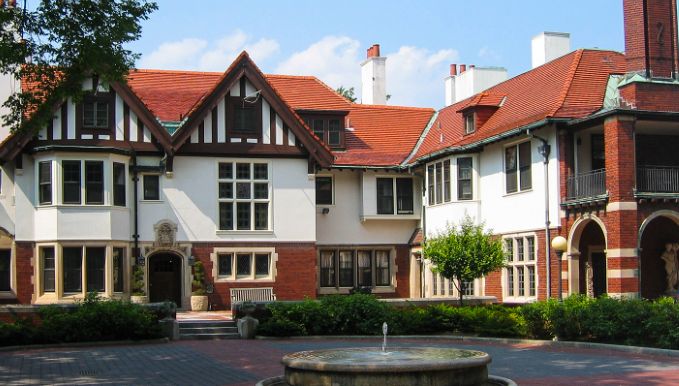George Gough Booth, a successful iron-working company owner from Windsor, Ontario, wed Ellen Warren Scripps, the eldest child of James Edmund Scripps, the founder of The Detroit News, and the couple raised five children in a tasteful urban setting in Detroit. George’s opportunity to join the Scripps family’s publishing empire in 1888 helped build The Detroit News into the city’s largest daily, and he began to purchase interests in several Michigan newspapers, which led to the establishment of Booth Publishing Company, the most extensive and profitable chain in Michigan’s history.
George and Ellen Booth longed to establish themselves in the country, where they could develop a fine estate on a far larger scale than was possible in the city. In 1904, they purchased a 174-acre farm in Bloomfield Hills, named it Cranbrook after the English town the Booth family hailed from, and immediately began improving the property by laying in roads, grading hillsides, creating lakes, erecting farm buildings, and initiating a massive planting campaign to cover the barren rolling terrain.
In 1906, the death of James Scripps precipitated plans for a full-scale move to Cranbrook. Booth called upon his long-time friend, the noted Detroit architect Albert Kahn, to prepare working drawings for the building of Cranbrook House, an English Arts and Crafts-inspired design that closely followed the style of his own home in Detroit. Ground was broken for Cranbrook House in January 1907, and the Booths took up residency in their new home in June 1908.
Work on the homestead continued steadily throughout the years, as outbuildings and wings were added, terraces extended, and gardens developed around the house. The most significant work was done between 1918 and 1922, a time which witnessed George Booth’s emergence as one of the principal patrons and leading spokesmen of the American Arts and Crafts movement. As befitting his interests in fine craftsmanship and design, George personally commissioned tapestries, wood carvings, furniture, metalwork, glasswork, fine bindings, and other decorative items from the workshops of leading American and European artisans and crafts firms for placement in Cranbrook House. He also acquired several important works of art by old masters for the residence.
Believing that their country estate should be given over to a larger public purpose, the Booths shifted their attention after 1922 toward the building of six institutions at Cranbrook: Brookside School for Children, Christ Church Cranbrook, Cranbrook School for Boys, Cranbrook Academy of Art, Cranbrook Institute of Science, and Kingswood School for girls. Today, Cranbrook Educational Community is a thriving center for education, science, art, and architecture.


